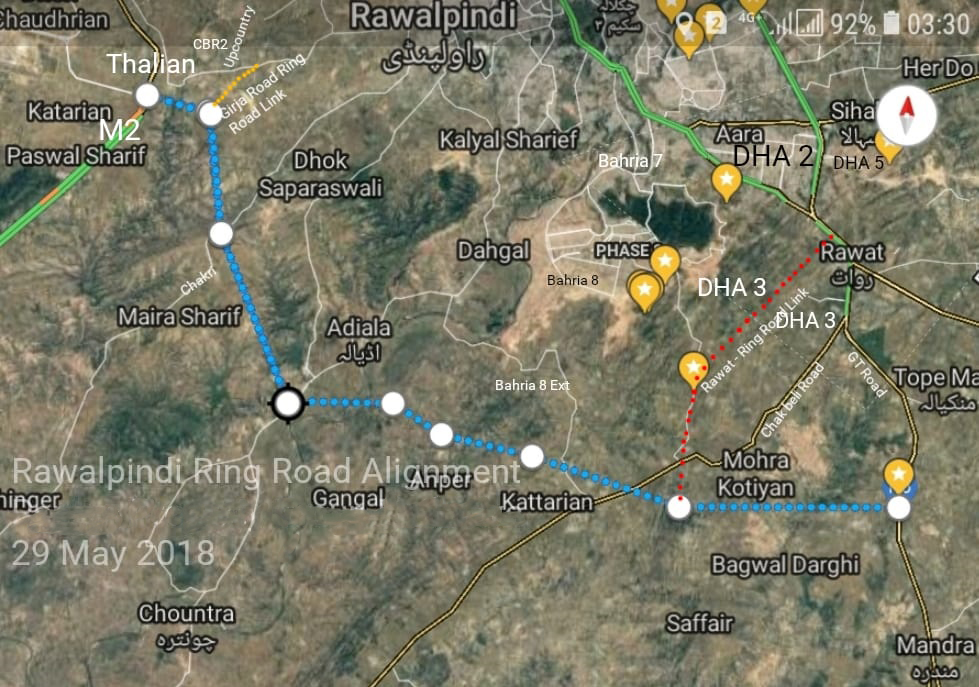
After the Islamabad International Airport, the Rawalpindi Ring Road (RRR) is to become the next big thing for the property market of the twin cities. While the road is meant to provide a direct, signal-free and shorter route to the airport Rawalpindi, the RRR itself is too big of a development to ignore.
We have been keenly following up on related news and update on the RRR, also referred to as the Rawalpindi Bypass; as soon as the route is marked and development work starts here, we will also start discussing the project’s impact on the housing societies it touches on its 38.25-kilometer long curvature.
Right now, we are sharing some project details, its expected route, the projects that are set to benefit from it and of course how soon should be expect development work to start on it.
Details on RRR project
According to a news report shared recently by local dailies, the RRR will be 38.25 kilometers long and it will be completed in a time frame of two years. The authorities concerned are to acquire 11,000 kanals of land for it, which is estimated to cost approximately PKR 4 billion. In this regard, Planning and Development Department (P&D) Punjab has given a green signal for providing funds for land acquisition during the fiscal year 2018-19. Please note that fund allocation for the RRR’s land acquisition has already been done.
The 300-foot wide RRR will have three link roads. The length of RRR’s link 1, i.e. Rawat Link, will be 12.5 kilometers, and Link (2) Girja Road and Link (3) Fateh Jang to GT Road will be 1.5 kilometer and 6.5 kilometers respectively. The right of way between the patch connecting Girja Road and Thalian Interchange will be 60 feet and 90 feet wide. There may or may not be some technical changes in the final design as the RRR feasibility study was completed in 2017.
In its initial design, the interchanges were proposed on GT Road, Chak Beli Road, Rawat Link Road, Adiala Road, Chakri Road, Girja Road, and Thalian Interchange. The number of interchanges the circular road will have isn’t confirmed so far as sources quote different figures. But we do know that GT Road and Rawat will have a cloverleaf interchange, while Adyala Road, Chakri Road, Girja Road will have a diamond interchange. In addition, it is expected that the RRR will use the existing interchange on Thalian.
The route
According to news sources, the starting point of RRR will be 10 kilometres away from Rawat on GT Road at Mouza Banth and it will end at Lahore-Islamabad Motorway M-2 on Thalian Interchange. From Banth, it will run along Mouza Mera Mohra and Bassali near Rawat Chak Beli Road. From there, it will pass adjacent to Mouza Lilla, Kamalpur, Trahia, Dhapia, and bisect Adyala Road at Khasal Khurd. The route will move to north-west side of the Adyala Road and head to Chakri Road and move further in the north western side to meet Thalian interchange on the M-2 Motorway.
Here is the expected alignment of the route:
Latest development
According to a news report, P&D Punjab and Asian Infrastructure Investment Bank (AIIB), which is headquartered in Beijing, China, have developed an understanding over the development of the RRR. While P&D has affirmed to reserve funds for land acquisition during the upcoming fiscal year, AIIB will arrange for the rest of the funds estimated at PKR 42 billion.
The funds for the project will be allocated in P&D’s budget for 2018-19, and that will also be the year when development work on the road will start.
Which societies will benefit from the RRR?
That’s the most important questions that concerns most of people watching out for the project closely. Many lesser-known housing societies will also start to catch investors’ attention with advancement in the RRR’s development, with some projects counting on it for their success. Some of these include Bahria Town Rawalpindi Phase VIII and Phase VIII Extension, many farmhouse projects on Adyala Road and Chakri Road including Royal Farm Houses, and also Blue World City, Al-Haram City, Al-Mairaj Garden, and Capital Smart City.
If the road is completed in the stipulated time, which is two years, we are looking at a medium-term investment in the above mentioned projects. The returns will, of course, be the highest for societies that currently feature cheaper options.
This was our update on the RRR, if you have feedback on the article or any questions for us, let us know through your comments.




No comments:
Post a Comment